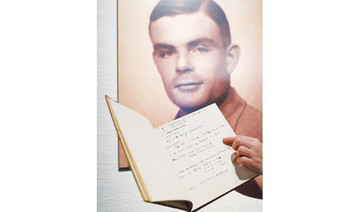LONDON: The rainbow flag is flying proudly Thursday above the Bank of England in the heart of London’s financial district to commemorate World War II codebreaker Alan Turing, the new face of Britain’s 50-pound note.
The design of the bank note, which is the most valuable denomination in circulation, was unveiled Thursday before it is formally issued to the public on June 23, Turing’s birthday.
The new note, which is laden with high-level security features, completes the bank’s rejig of its stable of paper currencies over the past few years. Turing’s image joins that of Winston Churchill on the five-pound note, novelist Jane Austen on the 10-pound note and artist J. M. W. Turner on the 20-pound note.
All the notes are made from polymer rather than paper, which means they should last longer and remain in better condition through their use.
Like the 20-pound note, which entered into circulation a little more than a year ago, the new 50-pound note incorporates two windows and a two-color foil that designers say will make it very difficult to counterfeit. There is also a hologram image which changes between the words “Fifty” and “Pounds” when the note is tilted from side to side.
Turing was selected as the new face of the 50-pound note in 2019, recognition for his pivotal role in breaking the Enigma code in World War II that historians say may have helped shorten the conflict by at least two years, saving millions of lives.
“There’s something of the character of a nation in its money, and we are right to consider and celebrate the people on our bank notes,” Bank of England Gov. Andrew Bailey said.
“Turing is best known for his codebreaking work at Bletchley Park, which helped end the Second World War. However, in addition he was a leading mathematician, developmental biologist, and a pioneer in the field of computer science. He was also gay, and was treated appallingly as a result.”
During World War II Turing worked at the secret Bletchley Park code-breaking center, where he helped crack Nazi Germany’s secret codes by creating the “Turing bombe,” a forerunner of modern computers. He also developed the “Turing Test” to measure artificial intelligence.
After the war he was prosecuted for homosexuality, which was then illegal, and forcibly treated with female hormones. He died at age 41 in 1954 after eating an apple laced with cyanide.
Turing received a posthumous apology from the British government in 2009, and a royal pardon in 2013.
WWII codebreaker Alan Turing honored on new UK bank note
https://arab.news/rjqbv
WWII codebreaker Alan Turing honored on new UK bank note

- The new note completes the Bank of England’s rejig of its stable of paper currencies over the past few years
- Alan Turing was selected as the new face of the 50-pound note in 2019
Arts festival’s decision to exclude Palestinian author spurs boycott

- A Macquarie University academic who researches Islamophobia and Palestine, Abdel-Fattah responded saying it was “a blatant and shameless act of anti-Palestinian racism and censorship,” with her lawyers issuing a letter to the festival
SYDENY: A top Australian arts festival has seen the withdrawal of dozens of writers in a backlash against its decision to bar an Australian Palestinian author after the Bondi Beach mass shooting, as moves to curb antisemitism spur free speech concerns.
The shooting which killed 15 people at a Jewish Hanukkah celebration at Sydney’s Bondi Beach on Dec. 14 sparked nationwide calls to tackle antisemitism. Police say the alleged gunmen were inspired by Daesh.
The Adelaide Festival board said last Thursday it would disinvite Randa Abdel-Fattah from February’s Writers Week in the state of South Australia because “it would not be culturally sensitive to continue to program her at this unprecedented time so soon after Bondi.”
FASTFACTS
• Abdel-Fattah responded, saying it was ‘a blatant and shameless act of anti-Palestinian racism and censorship.’
• Around 50 authors have since withdrawn from the festival in protest, leaving it in doubt, local media reported.
A Macquarie University academic who researches Islamophobia and Palestine, Abdel-Fattah responded saying it was “a blatant and shameless act of anti-Palestinian racism and censorship,” with her lawyers issuing a letter to the festival.
Around 50 authors have since withdrawn from the festival in protest, leaving it in doubt, local media reported.
Among the boycotting authors, Kathy Lette wrote on social media the decision to bar Abdel-Fattah “sends a divisive and plainly discriminatory message that platforming Australian Palestinians is ‘culturally insensitive.'”
The Adelaide Festival said in a statement on Monday that three board members and the chairperson had resigned. The festival’s executive director, Julian Hobba, said the arts body was “navigating a complex moment.”
a complex and unprecedented moment” after the “significant community response” to the board decision.
In the days after the Bondi Beach attack, Jewish community groups and the Israeli government criticized Prime Minister Anthony Albanese for failing to act on a rise in antisemitic attacks and criticized protest marches against Israel’s war in Gaza held since 2023.
Albanese said last week a Royal Commission will consider the events of the shooting as well as antisemitism and social cohesion in Australia. Albanese said on Monday he would recall parliament next week to pass tougher hate speech laws.
On Monday, New South Wales state premier Chris Minns announced new rules that would allow local councils to cut off power and water to illegally operating prayer halls.
Minns said the new rules were prompted by the difficulty in closing a prayer hall in Sydney linked to a cleric found by a court to have made statements intimidating Jewish Australians.
The mayor of the western Sydney suburb of Fairfield said the rules were ill-considered and councils should not be responsible for determining hate speech.
“Freedom of speech is something that should always be allowed, as long as it is done in a peaceful way,” Mayor Frank Carbone told Reuters.













